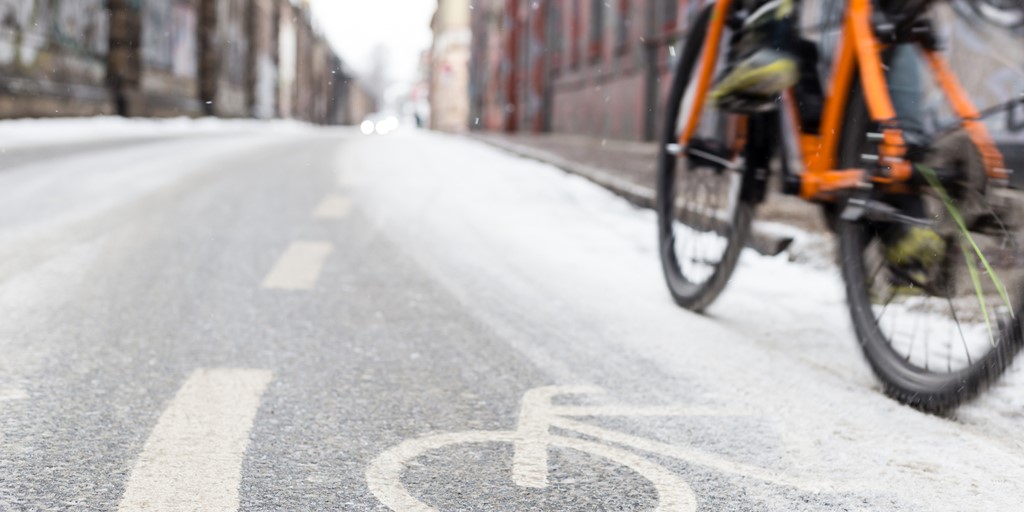12 tips for cycling in winter
11 January 2021

Some cyclists lock their bikes away in winter and hibernate until spring. Some turn to indoor cycling. But a select few brave the elements, refusing to let a bit of snow get in the way of their bike ride. If you belong to the latter camp, this article is for you.
Winter cycling presents some unique challenges and risks, but you’ll be prepared to tackle them after reading our tips for riding a bike in winter.
1. Wear appropriate clothing
You might think this is as simple as wrapping up. However, throwing on extra layers will only make you sweat and more likely to catch a chill. Not to mention, cycling is hard enough at the best of times—you don’t want to add unnecessary wind resistance or extra weight to the mix.
Winter cycling clothes that are high-wicking, lightweight, and highly insulative will keep you well-ventilated, warm, and not carrying excess weight.
2. Lower your tyre pressure
Tyres with high pressure are great in the spring and summer. They allow your bike to ride more smoothly and reduce friction on the road, allowing you to go faster for longer.
When cycling in winter, however, it’s a different story. Given the prevalence of slush, snow, and ice, high tyre pressure reduces your bike’s grip on slippery surfaces - this can cause nasty crashes. Lowering your tyre pressure will flatten the tyre against the surface, giving you more grip.
Test how low you want your tyre pressure before heading out on a ride—and don’t lower it so much that it’s flat.
3. Get mudguards
You’ll often find yourself coming away from a bike ride covered in just a few mud splashes, so you might not have a mudguard for your usual rides.
It’s well worth investing in one for winter road cycling, though. If not, you’ll find yourself drenched in ice-cold puddle water and snow you’ve kicked up from the path, which can have some pretty serious consequences.
For example, hypothermia occurs when your body loses heat faster than it can produce heat, causing dangerously low body temperature. It’s easy to see how the winter elements could pose this threat, especially if you’ve not layered up properly and are already drenched in sweat.
Apart from anything else, it’s very unpleasant to have ice raining down on you or your riding partner. So stay safe when cycling in cold weather by installing mudguards on your bike.
4. Clean and maintain your bike after your winter rides
You should always hose, wipe down, and re-oil your bike after a ride, especially in winter.
After a ride, there’s every chance your gears and brakes will be covered in snow and the rest of your bike in freezing water. Not to mention all the grit and dirt your wheels have kicked up.
Grit used to melt ice on the road contains salt, which can corrode bike components if left alone.
Applying some WD40 before a ride will help your gears resist moisture and ice, as will a quick spray after the ride. You could also apply a silicone spray like Muc-Off to your frame and suspension to resist mud and keep your suspension smooth and grit-free, but make sure to keep it away from your brake pads or disks.
5. Get some front and rear lights
Wintertime means we only get about eight hours of light each day. Even then, you’d hardly call it bright outside.
Therefore, consider fitting a rear and front light to your bike. What’s more, they’re an absolute must if you intend to do any riding at night.
It’s typical practice to fit a red light to the rear of your bike and a white headlight to the front—this helps motorists, cyclists, and pedestrians know which way you’re facing and moving. The headlight will also help you see where you’re going. Bike headlights come with different features and varying luminosity, so do your research based on your intended use.
6. Bring a thermal flask
You can warm yourself from the inside on those chilly winter rides if you bring a flask of coffee or soup. This is perfect if you stop for a rest at any point, considering a lack of exertion will cause your temperature to drop if you sit still for too long.
You should still bring a water bottle, but keeping it in a backpack or wrapped in a cloth to insulate it is best. Doing this will protect it from freezing or chilling to the point where it reduces your core temperature when you drink it.
7. Bring a puncture repair kit
Again, this is something you should always bring on a ride. But if you’re usually lax about it, you can’t be when cycling in winter.
Snow can be a sponge for all kinds of thorns and shale—while they might fall flat onto a stone path, they can land upright in the snow. The consequences of a puncture in winter are more severe, too. You risk catching hypothermia by pushing a bike home in the cold.
Plus, you can always bank on the old wisdom that if a puncture can happen, it will, and usually at the worst time—hence why you need to be prepared.
8. Take corners more carefully
We develop a sixth sense for taking corners lower, faster, and tighter the more we grow familiar with the physics of cycling. Indeed, a lot of complicated science goes into a lean around a corner, but it all comes down to one factor: grip.
Grip is scarce in winter, so make sure you slow down for corners. Don’t make dramatic movements that will shift your centre of gravity, and maintain a wider turning circle.
9. Eat enough before heading out
If you’re going on a long ride in winter, your body will burn more calories than in temperate conditions as it struggles to maintain your core temperature. This means you need lots of fuel in your belly to get you through it.
A pleasant alternative is to make a pit stop at a warm and cosy café. If you opt for this, try to leave your bike somewhere it won’t be subject to the elements. If all else fails, ask the café owner for some warm water to thaw out your bike.
10. Consider using an older bike for winter rides
Given how punishing winter cycling can be on bikes and how much it increases the likelihood of crashes, many riders use an older bike with cheaper components instead of their main bike.
Consider doing this if you have multiple bikes. In addition to the benefits already mentioned, you could kit out this bike specifically for the challenges of winter.
For example, you could fit mountain bike tyres to give you more purchase on slippery surfaces. You could even make it a fat bike if you get a lot of snow where you live.
11. Plan your ride
The importance of planning ahead when cycling in winter cannot be understated. Knowing where you are, where you’re going, and what you’re likely to face is imperative—particularly if you find yourself in trouble.
That’s why you need to know your route in terms of timings, navigation, hazards, and terrain. It would help if you also had an idea of what the weather is supposed to be like throughout the day.
We also recommend letting someone know when you’re leaving and when you intend to be back, especially if you live somewhere more remote or could be out after dark.
12. Ride in a group
The winter elements are harsh—but there’s nothing like moral support to get you through them. If you ride with a friend when winter road cycling, you can take turns shielding the other from the wind and sleet (think of it like a mini-peloton) and keeping each other distracted from the cold by making conversation.
With winter cycling being a more dangerous type of bike ride, riding with a friend means you’ll have help in the event of an emergency, too.
Specialist cycling insurance through Cycleplan
Winter cycling presents several risks, most of which can be mitigated by the above steps. However, as careful as you are, you can still hurt yourself or damage your bike.
At Cycleplan, we arrange specialist cycling insurance for damage (accidental and third party), loss, and theft. We even cover personal accidents, meaning you’ll be compensated if you sustain a serious injury while cycling.
Get an instant online quote today and see what we can do for you.
Please note the information provided on this page should not be taken as advice and has been written as a matter of opinion. For more on insurance cover and policy wording, see our homepage.
